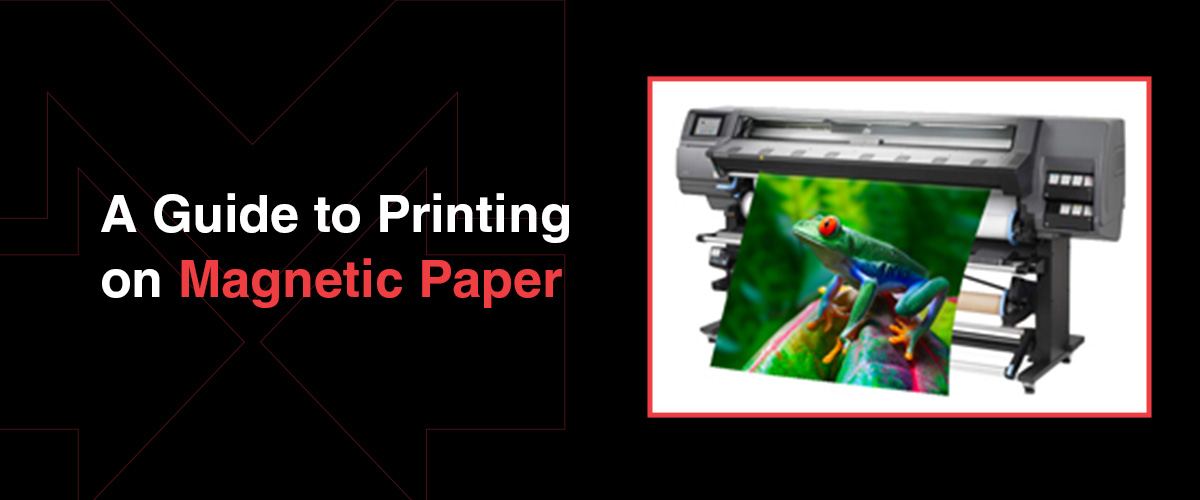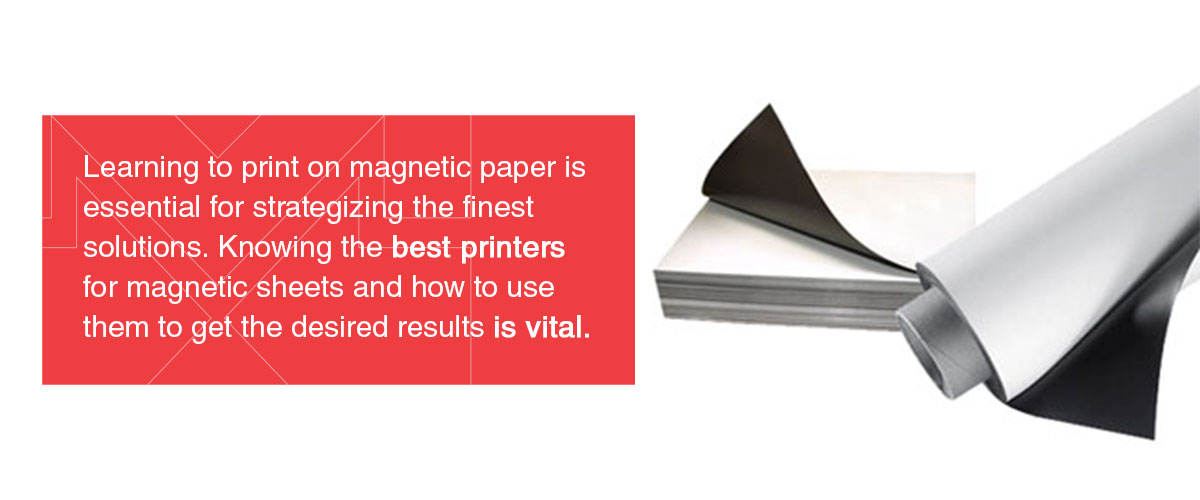
A Guide to Printing on Magnetic Paper
Printable magnetic sheets have grown popular over the years due to their high-quality outcomes, durability, broad applications, and cost-saving attributes. They eliminate the tedious printing and installation processes and offer convenient alternatives for creating labels, designs, and post advertisements. This magnetic paper guide will give you all you need to know about flexible magnetic sheets.

What Are Flexible Magnetic Sheets?
Flexible magnetic sheets are thin plastic layers with millions of magnetized ferrous particles embedded in them. The steel particles, just like any other material, are made of atoms. These atoms have electrons that carry electrical charges. The motion of the electric charges causes the materials to be magnetic.
Typically, a printable magnetic sheet is manufactured with rubber polymer resin and ferrite powder. The ferrous powder contains enough iron to produce a magnetic field and is mixed with a binding agent or an adhesive and applied to the synthetic substrate, giving it magnetic properties. Flexible magnetic sheets can bend without breaking or sustaining damage, making them the preferred magnetic solutions for multiple applications.
Types of Flexible Magnets
There are three types of flexible magnets. Let us take a look at each in detail:
- Flexible magnetic sheets: These are broad, flattened sheets of rubber with magnetic properties used in displaying labels, designs, or advertising. The standard roll length of flexible magnetic sheets is 25, 50, 100, or 200 feet, with a standard roll width of up to 24.375 inches. They are flexible, with a width between 0.012 inches and 0.030 inches.
- Flexible magnetic tapes: These are permanently flexible magnetic materials in strip or extrusion form with broad applications, including floor signs, advertising, warehouse labeling, toys and games, and planning boards. They are thicker than magnetic sheets, with a standard thickness between 0.025 inches and 0.250 inches. Magnetic tapes have a standard width between 0.50 inches and 3.0 inches and roll lengths ranging from 100 to 200 feet.
- Custom-made flexible magnets: Personalized, flexible magnets allow you to create and design the sheets or tapes according to your needs. Various applications may require unique specifications, making customized, flexible magnets ideal for filling those gaps. You can module one depending on your desired length, width, and thickness and choose a preferred material and design.
Applications of Flexible Magnets
Flexible magnets are optimized to make them useful for multiple applications. The material's flexibility and durability offer unmatched versatility with limitless possibilities for innovation and creativity. Common flexible magnet applications include the following:
- Labeling: Labels are essential for easy identification and organization of items. You can tag items in homes, classrooms, offices, warehouses, or industries with flexible magnets. When you want to change or replace the labels, you can easily do so without damaging the holding material's surface.
- Signs and displays: It is essential to alert and direct employees or visitors of possible hazards to ensure optimum safety. Similarly, clear and readable instructions increase efficiency and streamline workflow. Printable magnetic sheets are a cost-effective and straightforward way of providing relevant information.
- Advertising: Marketing can help you reach your target audience and attract them to patronize your goods and services. Many industries use flexible magnets because they are robust and provide clean prints. For example, instead of branding your vehicles with paint, which can be costly and tedious, flexible magnets are an alternative.
Some additional applications of flexible magnets are:
- Door and window seals
- Packaging sealing
- Menu boards
- Display boards
- Crafts
- Bin markers
- Hot stamping
- Architectural signage
The Benefits of Printing on Magnetic Paper
Magnetic papers have maintained their popularity over the years for the following reasons:
- Printed compatibility: Magnetic paper is compatible with multiple printer types. This feature makes it possible to print various dimensions and designs, increasing your return on investment.
- Usability: Magnetic papers are one of the most widely used products regarding labeling, advertising, and design printing. Their flexible and magnetic nature allows you to fix them on many surfaces, such as vehicles, doors, boards, fridges, and many more. There are several adhesive options as well as color and material choices.
- Durability: Magnetic sheets are robust and can withstand harsh conditions over several years. They can be bent and rolled without sustaining substantial impact or damage. Additionally, they can retain their magnetic strength over long periods unless exposed to more intense magnetic fields.
- Ease: Flexible magnetic sheets and tapes are relatively easy to produce and use. You can cut them with traditional tools and fix them without particular expertise or advanced skills. A simple search will provide a solution when you face installation challenges.
- Cost-effective: Magnetic papers are less expensive and easy to maintain. You can personalize them depending on your budget without compromising quality. Because they last long, you only need to make new prints when you need further information or design or when different applications require specific modifications.
- Speed: Flexible magnets offer quick solutions to your printing problems. The printing process is swift depending on your demands and can be fixed within considerably shorter times. They are also easy to replace, allowing you to save time for other essential tasks.
- Convenience: The speed, ease, and usability of printing and using magnetic sheets make them a convenient alternative. They are easy to customize with broad applications, eliminating the need for several designs and printing processes. Regardless of the design choice or specifications, magnet sheets can be tailored to suit your demands.
- Flexibility and adaptability: How you use thin-paper magnets is only limited by your imagination. This puts you in charge of the creative processes and helps you plan solutions, even unusual demands. With consultation and research, you can develop a module to fix the problem.

Printing Processes for Magnetic Sheets
Learning to print on magnetic paper is essential for strategizing the finest solutions. It is vital to know the best printers for magnetic sheets and how to use them to get the desired results.
Choosing the Correct Printer
The type of printer you need depends on what you are printing. The available printer types include:
- Digital printers: These are useful for printing images and words from online sources. They are quick and workable for different sizes and shapes.
- Offset printers: These offer high-quality images with a long life span. They take extended periods to complete due to the outcome they produce and are helpful for books, flyers, newspapers, and brochures.
- Large format printers: Large format printers are used for large paper or material prints. You can use them to print banners, construction plans, and architectural blueprints.
- Screen printers: If you are printing on fabrics and textiles such as clothing, use screen printers. You can also use them for delicate materials such as balloons and medical devices.
- Flexography printers: Flexography printers are excellent for less standard printing materials such as cardboard, plastic, and foil. You can also use them for newspapers, packaging materials, and wallpapers.
- Desktop inkjet printers: These are the most common printers for businesses and homes. You can use them for printing documents and images, graphics, banners, and magnetized materials.
Printing on Magnetic Paper
The following steps will guide you through how to print on magnetic paper:
- Cut the magnetic rolls down to size.
- Locate the white side of the paper where the information or design will be printed and place it in the printer. Printing on the wrong side can cause the printer to malfunction.
- Set the printer to the highest resolution available.
- Print and wait a few minutes for it to dry before touching it.
- Apply it to the desired surface.
Tips for Printing on Magnetic Sheets
There are essential things to keep in mind when printing on magnetic sheets:
- Some digital printers have metal plates, which may cause feed challenges. In such cases, cover the plates with thin cardboard.
- For printers struggling to print your desired magnetic material, use a thinner product to test if it resolves the issue.
- You can print magnetic sheets with ultraviolet (UV), solvent, and latex ink.
- Eco-solvent, solvent, and UV inks work best for magnetic vinyl, while aqueous inks work best for paper topcoat products.
Browse Printable Magnets From Magnum Magnetics
Printable magnets allow you to print information or designs on several materials, including paper, vinyl, and various specialty films. When printing on magnetic sheets, it is crucial to use a printer that matches your desired design and material type. The material you use should also be qualified to deliver the optimum results.
Magnum Magnetics is the largest printable magnet manufacturer and supplier in the United States, offering superior products at competitive prices. We offer clear and quick answers to customers and partner with you to create what you need. Feel free to browse our products or contact us with all your questions!

